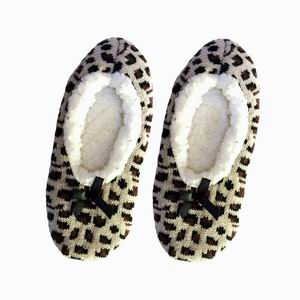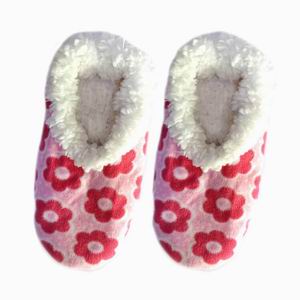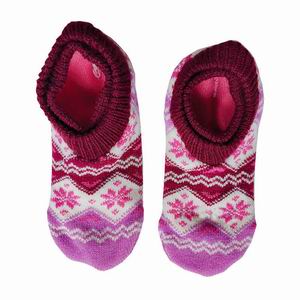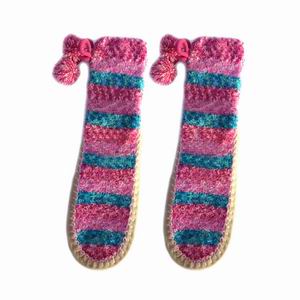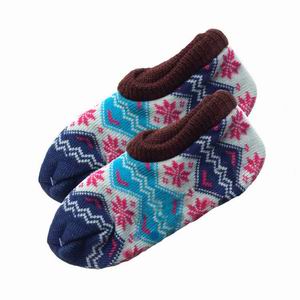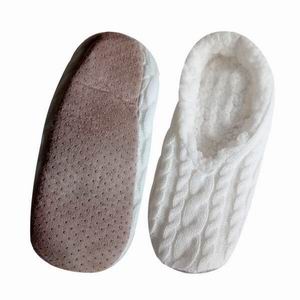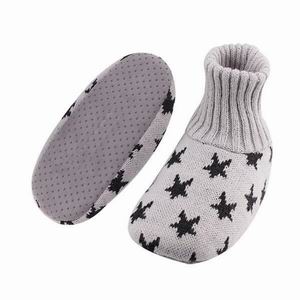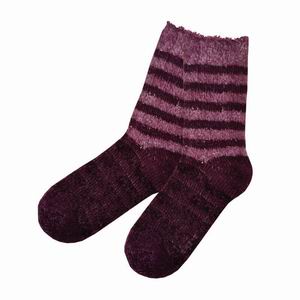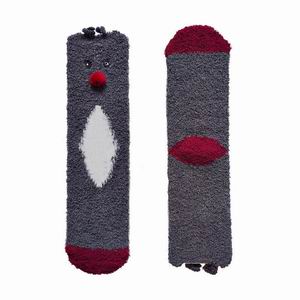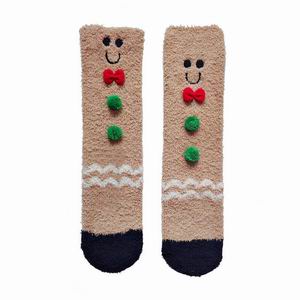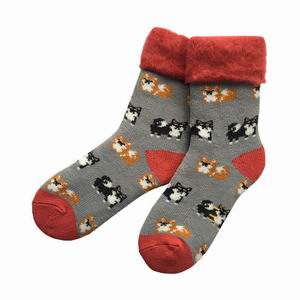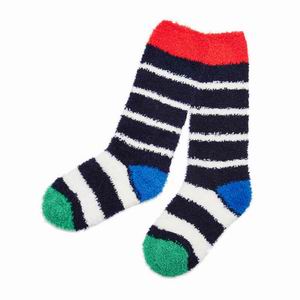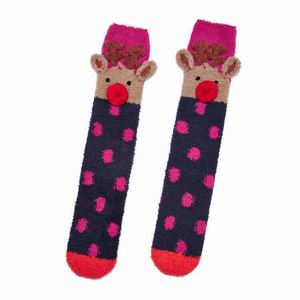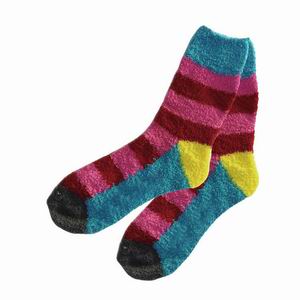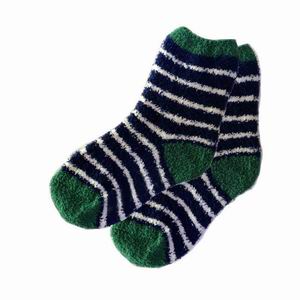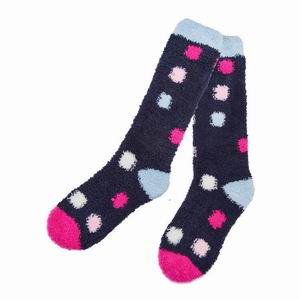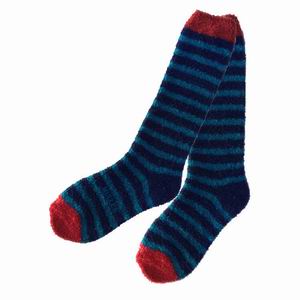
Slipper Socks Manufacturer from China
Our Main Products
| Serial | Categories | Material | Needle | Terry | Gauge | Other |
|---|---|---|---|---|---|---|
| 1 | Dress Socks | Bamboo, combed cotton, organic cotton and merino wool | 108, 120, 144, 168, 200 | —— | 3.5, 4.0, 4.5 | Business socks, casual socks |
| 2 | Slipper Socks | Polyester, acrylic, bamboo, organic cotton and merino wool | 56, 72, 84, 96, 108, 120 | —— | 3.5, 4.0, 4.5, 5.0 | single or double-layer socks |
| 3 | Work Socks | Bamboo, organic cotton | 108, 120, 144, 168, 200 | 4-5mm | 3.5, 4.0, 4.5, 5.0 | bamboo work socks, cotton work socks |
| 4 | Sport Scocks | Coolmax, thermolite, bamboo, merino wool, organic cotton | 120, 144, 168, 200 | 2-3 mm, 4-5mm | 3.5, 4.0, 4.5, 5.0 | hiking socks, running socks, ski socks |
| 5 | Baby Tights | Modal, cotton, bamboo, nylon, spandex, polyester. | 120, 144 | —— | 3.5, 4.0, 4.5 | baby tights, baby leggings |
How are socks manufactured?
1.Design
| Serial | Plan | Content |
|---|---|---|
| 1 | Referencing Existing Samples | By analyzing and referring to existing sock samples, you can gain a deeper understanding of design elements and structural features, and make appropriate fine-tuning of the sample style. |
| 2 | Using Vector Graphic Software for Design | Use professional vector graphic design software (such as Adobe Illustrator or CorelDRAW) to create sock designs, combining your own ideas and market trends. |
Whether you refer to existing samples or design your own using vector graphics software, you need to communicate closely with the manufacturer to make necessary adjustments to ensure that the final product meets design expectations and quality standards.
2.Negotiation
| Serial | Items | All types of socks are involved |
|---|---|---|
| 1 | Yarn Count | 21s and 32s |
| 2 | Yarn Material | Bamboo fiber, combed cotton, merino wool, modal, coolmax, thermolite, viscose rayon, spandex |
| 3 | Feeding Mode | Single-sided, double-sided, concave-convex |
| 4 | Jacquard Pattern | Stripes, plaids, flowers, animals and other patterns |
| Serial | Items | Slipper socks will be extra involved |
|---|---|---|
| 1 | Yarn Type | Fluffy yarn, chenille yarn, feather yarn, centipede yarn |
| 2 | Dispensing Glue Material | Silicone has strong adhesion, washing resistance, comfortable handle and good environmental protection. PVC has strong adhesion, water resistance and high cost performance. |
| 3 | Dispensing Glue Shape | Socks surface uses fabric such as polar fleece and coral fleece. Socks inside uses sherpa fabric and plush fabric. |
| 4 | Accessories | It mainly includes pom poms, bows, animal heads, etc. Their use will make slipper socks look more lovely. |
3.Sampling
2.1 Sampling
Before bulk production, we create a technical sheet that contains are the information to produce the desired socks. Sample pairs are produced and sent to client for quality, size, color, drawings and other elements confirmation. We only start production when the samples are approved. If required we can perform test reports.
| Serial | Attention | Content |
|---|---|---|
| 1 | Airtight | The socks are designed with mesh and yarns such as bamboo fiber or Coolmax to enhance breathability and improve moisture wicking effect. |
| 2 | Grind the Achilles Tendon | When running, sports socks use Achilles tendon anti-wear pads, which can effectively prevent high-frequency friction between the Achilles tendon and sports shoes. |
| 3 | Grind the Soles | For flat feet, small terry tissue is used instead of flat tissue, which increases the cushioning when walking and makes it no longer easy to wear the soles of the feet. |
| 4 | Sock Soles Slippery | We add a ring of elastic with appropriate elasticity to the arch of the foot to prevent the socks from slipping when walking or exercising and enhance stability. |
| 5 | Easy to Slip Off | The sock cuffs are made of rubber bands with high-quality lifting strength and elasticity, which will prevent them from slipping or pinching your ankles. If it is a single-layer sock, you can apply a layer of non-slip silicone inside the sock opening as needed. |
| 6 | Poor Elasticity | Use good quality spandex to enhance the elasticity of the socks. |
| 7 | Easy to Break Holes | Sock toes, soles, heels and other areas prone to holes are reinforced with high-quality nylon yarn to enhance firmness. |
| 8 | Thick Toe Seams | A sewing worker with more than 10 years of experience will make the sock toe close to seamless if computerized sewing is used; if eye-stitching is used, the sock toe will be smooth and seamless. |
| 9 | Seams Open Easily | The use of high-quality nylon yarn as the suture line at the sock toe and ankle seams can increase the firmness of the seams, and at the same time, no tiny openings are missed when the sock toe is sewn. |
4.Knitting
2.2 Knitting
After the sample is confirmed, we produce the order as per the established specifications and requirements. At present, we have 6 skilled mechanics, 30 experienced knitters, and 80 computerized sock machines. The sock machines are equipped with single and double syringes of different gauges and needles.
| Serial | Types | Gauges | Needles | Threads | Jacquard |
|---|---|---|---|---|---|
| 1 | Single Syringe | 3.5, 4.0 4.5 | 108, 120, 132, 144, 168, 176, 200 | 2F are used for knitting and 8F(8-color) are used for jacquard. | single-sided colored jacquard |
| 2 | Double Syringe | 4.0,4.5 | 108, 120, 144, 168, 200 | 2F are used for knitting and 8F(8-color) are used for jacquard. | double-sided colored jacquard, concave-convex jacquard |
5.Linking
Toes Linking mainly uses two methods to link the head, such as manual cross-stitching and straight blind stitching.
Straight Blind Stitching. This method uses a straight sewing machine, uses overlock stitching, and wraps the sock toe coil with stitches to produce a relatively flat sock toe.
Manual Cross-Stitching. This method uses a round socks machine, and the stitched socks toe coils are sequentially put on the needle of the sewing machine to sew. The socks toe produced has no ribs.
Crotch Linking for Tights. Precisely cut front and back pieces according to the tights design, ensuring the alignment is accurate to maintain comfort and aesthetics in the crotch area. Crotch stitching usually involves flatlock or coverstitch machines to create seams with high strength and elasticity, complemented by elastic threads to enhance overall flexibility and adaptability. Flatlock seams are a common choice as they remain smooth on both the inside and outside of the tights, preventing irritation on sensitive babyskin.
6.Boarding
All socks pass through are boarding machines to give them a clean look and feeling before being packed. There are 1 rotary electric steam boarding machine, which is generally used for setting short socks, and 2 hanging electric steam boarding machines, which are suitable for all types of socks.
7.Inspection
Quality inspection takes placed in every step of the production process and the most thorough product quality inspection takes placed right before packaging in order to guarantee that no socks are defective or contaminated. Quality inspections can be arranged with external entities.
| Serial | Lists | Content |
| 1 | Deal with the Excess Threads Inside the Socks | Use small, sharp scissors to make clean cuts close to the sock’s surface without cutting into the sock itself. This reduces the chance of threads catching or tangling during wear. |
| 2 | Check the Lengths and Holes of Socks | Lay each sock flat on a measuring board or next to a ruler, in a relaxed position with no stretch or compression, making sure the heel and toe are properly aligned. Pay attention to seams and joins, which are common locations for holes to develop due to stitching failure. |
| 3 | Formaldehyde Content | Class A products ≤ 20mg/kg, which refer to products used by infants and young children.Class B products ≤ 75mg/kg, which refer to products that come into direct contact with the skin when worn. |
| 4 | Ph Value | 4.0-7.5, it can be understood that Class A and Class B products should be in this range (there are no Class C products in socks). |
| 5 | Bad Smell | None. There should be no smell in finished socks. |
| 6 | Decomposable Aromatic Amine Dye | Disable. Some dyes are harmful to the human body and even cause canceration, such as azo dyes, the standard stipulates that the use of these dyes should be prohibited, and the detection limit should be ≤ 20mg/kg. |
| 7 | Color Fastness to Water | It refers to the change of color fastness of socks after exposure to water. According to the test of discoloration and staining, class A products ≥ grade 4, class B products ≥ grade 3. |
| 8 | Color Fastness to Acid and Alkali Perspiration | The change of color fastness of socks in the presence of acidic or alkaline sweat can be divided into discoloration and staining tests, class A products ≥ grade 4, class B products ≥ grade 3. |
| 9 | Color Fastness to Dry Friction | The change of color fastness of socks under the condition of non-wetting and friction at room temperature: class A ≥ grade 4, class B ≥ grade. |
| 10 | Color Fastness to Saliva | It refers to the change of color fastness of socks when they encounter saliva. Divided into discoloration and staining test, Class A products ≥ grade 4, Class B products are not tested. |
8.Packaging
After passing quality inspection, it will be packaged according to customized requirements. At present, there are packaging cardboard, cardboard bags, cartons and other types of packaging. It involves packaging materials such as packaging cardboard, cardboard bags, cuff labels, size stickers, sock hangers (paper cards), waist seals, packaging hooks, sock toe/cuff fasteners, outer packaging cartons and other packaging materials.
9.Delivery
Choose the appropriate freight method, prepare and review all required export documents, such as commercial invoice, packing list, certificate of origin, etc., comply with relevant international trade regulations and standards, and ensure smooth customs clearance procedures in the destination country in cooperation with logistics partners.
Our Certification
Connect with Us!
Let Muller Textile be your partner in delivering high-quality bamboo socks that your customers will love. Contact us for samples, quotes, and to learn how we can help grow your product line with our exceptional socks.


